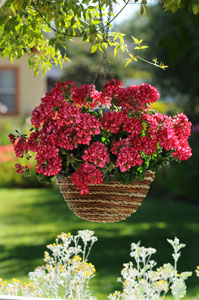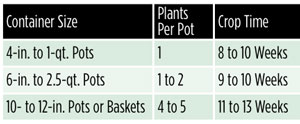8/27/2015
A “Focus” on Ivy Geranium
Ryan Hall

The ivy geranium has come a long way in its development as a bread-and-butter garden plant. One would be hard pressed in Europe a century ago or today to not experience the classic look spilling from window boxes on quaint cottages and Mediterranean villas.
In comparison to their zonal cousins, ivies have proven to be quite tolerant of various garden conditions, withstanding a range of light and temperatures, and having the ability to rebound after periods of dry-down. This toughness is evident by just looking at their leaves, which are almost succulent in nature. Ivies are perfectly at home in areas of the garden where they can trail and sprawl to reach their full potential. This trailing habit is ideal for window boxes and hanging baskets, where they reward gardeners with hundreds of blooms throughout the season.
Breeding companies around the world have continued to work on refining this already resilient class, focusing on widening the color palette, as well as improving heat performance. Most notably, breeders have focused on improving habits in an attempt to tame ivies’ naturally sprawling growth and open habits. Although this vigorous trailing habit is great when one has the room to let it go, ivies’ habits can be challenging for small-space gardens and especially in the production greenhouse, where growers are challenged to control gangly habits and present them in a retail-friendly package.
Understanding the challenges of growers and the increased space limitations at a consumer level, Ball FloraPlant developed the first compact, dark-leafed series of ivy geranium called Focus. Focus’ compact, well-branched habit makes them ideal for smaller pot programs, such as 1-qts.
Focus maintains a tidy habit while still having that classic ivy geranium look suitable for hanging baskets and window boxes. The series’ dark foliage gives it an upscale appeal paired with fantastic high-impulse colors like Red Ice and Hot Pink. With the emphasis on giving growers a real solution in ivy geraniums, Ball FloraPlant also focused on selecting for high series uniformity resulting in Focus being another Real Series designation from Ball FloraPlant. This Real Series uniformity gives growers a package of superior genetics paired with predictability in production. Ivy geraniums, and Focus in particular, are straightforward in their culture, but here are some tips on how to maximize the potential of Focus and deliver a top-quality product to market of this garden favorite.
 Crop time: Rooted liner to finish
Crop time: Rooted liner to finish
Focus are moderately fast growers. Plants should be given enough time to maximize branching and container fill. Avoid pushing growth with fertilizers high in ammoniacal nitrogen, as this will reduce flowering and produce excessive vegetative growth.
Media & pH
Focus Geraniums prefer a well-drained media that’s allowed to dry in between waterings. Focus, and ivy geraniums in general, prefer a lower pH media compared to zonals. A standard bedding plant pH range of 5.8 to 6.2 also works well for Focus.
Irrigation
Good irrigation is a key factor in producing high-quality ivy geranium plants. Growers should avoid large swings in media moisture, with the goal of maintaining even moisture levels. Avoid overly saturated media, especially going into the evening and on cloudy days. Significant swings in moisture, as well as wet low-light conditions, can lead to the occurrence of Oedema.
Temperatures
Ivy geraniums prefer moderate temperatures. Growers should avoid excessively high temperatures, as this can delay growth and make plants susceptible to Oedema. Ideal production temperatures are from 65 to 76F (18 to 24C) days to 62 to 67F (16 to 19C) nights.
Light levels
Ivy geraniums prefer bright, but indirect light, and generally should be grown under lower light compared to that of zonal geraniums. Light levels of 2,500 to 4,000 f.c. are ideal. Excessive light may result in delayed growth and hardened foliage.
Fertilizer
Ivy geraniums are moderate feeders and do well with a constant feed regime of 225 to 300 ppm N. Ivies prefer higher levels of Iron and Calcium. Growers should supplement with chelated Iron and Calcium Nitrate as needed for superior growth.
PGRs
Focus Ivy Geraniums are naturally compact and require less PGRs than standard ivy geraniums. Cycocel at a rate of 750 to 1,500 ppm is effective at controlling growth, especially when growing smaller containers. PGRs are generally not needed when growing larger containers, such as 10- to 12-in. hanging baskets.
Pest & diseases
Exercising solid IPM practices is the best way to manage pests on ivy geraniums. Growers should be aware and scout regularly for fungus gnats, thrips, aphids and mites. Proper moisture and environmental management is the best way to control diseases. Growers should look to avoid common ivy geranium diseases, such as Botrytis, Pythium and Xanthomonas with regular scouting and best IPM practices.
Even with the development of popular interspecific hybrids, ivy geraniums are still holding their place in the garden. It’s hard to beat this classic look that’s been a part of gardens for centuries. Now with improved breeding, the ivy geranium is here to stay even longer. Focus Ivy Geraniums, with their compact controlled growth and high series uniformity, give growers that extra edge to continue to provide this garden classic for decades to come.
GT
Ryan Hall is Product Manager for Ball FloraPlant, stationed in Arroyo Grande, California.